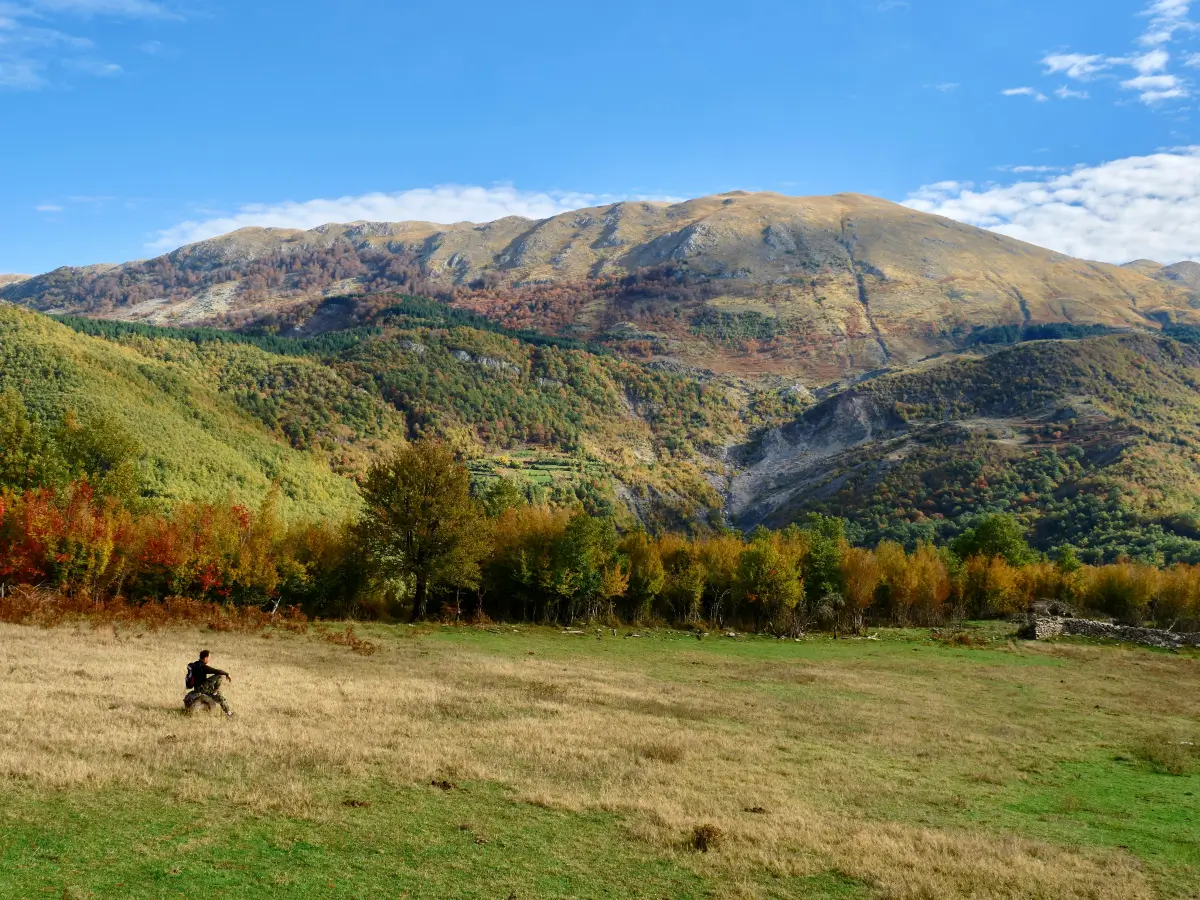Albania is one of the most mountainous countries in Europe, and its landscapes are still largely untouched. For hikers, this means endless access to raw beauty — sharp peaks, deep valleys, glacial lakes, and traditional mountain villages frozen in time.
While the north is known for its dramatic alpine terrain, the south offers spiritual mountains and sea-view hikes. Most trails remain free of crowds, offering a rare sense of solitude in nature. Hiking in Albania is not only about elevation — it’s about immersion.

The most prominent mountains in Albania
Mount Korab – Albania’s highest peak
At 2,764 meters, Mount Korab is the tallest mountain in Albania and sits right on the border with North Macedonia. The trail is long but steady, passing alpine pastures, shepherd huts, and wide open landscapes.
Hikers typically start from the village of Radomirë. The full ascent takes 7–9 hours round trip and is best attempted in summer or early autumn when the trail is clear of snow. While Korab is not technically difficult, it requires endurance and orientation.
Mount Jezerca – The crown of the Albanian Alps
Standing at 2,694 meters, Jezerca is the second tallest mountain and the highest in the Accursed Mountains (Albanian Alps). The climb is steep, with exposed ridges and scree fields. It’s a favorite among experienced climbers looking for a technical challenge.
The views from the summit stretch across Montenegro and Kosovo, with sharp limestone peaks filling the horizon. Most routes start from Theth or Valbona, and this climb is only recommended with proper gear or a guide.
Mount Tomorr – The spiritual mountain
Located in central Albania, Mount Tomorr (2,416 meters) is sacred in both Christian and Bektashi Muslim traditions. It is not just a hike — it’s a pilgrimage. The mountain hosts thousands of visitors during late August, when Bektashi believers gather for spiritual rituals.
Beyond the cultural significance, the hiking route offers a blend of forest trails, open rock plateaus, and panoramic views of Berat and the surrounding valleys. The trail can be reached from Poliçan or from the southern side near Çorovodë.
Mount Gjallica – The silent giant of Kukës
With an elevation of 2,489 meters, Mount Gjallica rises above the city of Kukës in northeastern Albania. It offers a peaceful alternative to the crowded northern trails. The route passes through pine forests and opens into panoramic ridges, overlooking the Drin River and Kukës Lake.
The area is not yet developed for tourism, which makes it ideal for experienced hikers seeking isolation and wild terrain.

Mount Dajti – Tirana’s local peak
Although only 1,613 meters, Mount Dajti plays an important role in daily life. Just 25 minutes from Tirana, it’s the easiest mountain to access, thanks to the Dajti Express cable car. From the upper station, hikers can explore the plateau or climb further toward the summit.
It’s a popular day escape, with restaurants, trails, and forest paths that appeal to both locals and visitors.
Best regions for hiking in Albania
While individual peaks offer strong highlights, Albania’s hiking magic truly comes alive in broader regions where entire networks of trails, villages, and landscapes connect.
Theth and Valbona – Albania’s alpine heart
The Valbona–Theth trail is the most famous hike in the country. It crosses a high mountain pass at over 1,800 meters and connects two of the most picturesque villages in the Alps. The trail takes 6–8 hours and passes rivers, waterfalls, wildflowers, and centuries-old guesthouses.
This region offers dozens of side trails, including to the Blue Eye of Theth, Grunas Waterfall, and the Kaproli peak viewpoint. Local families offer overnight stays with meals, making it ideal for multi-day trekking.
Llogara Pass and the Ceraunian Mountains
For coastal hikers, Llogara Pass provides access to trails that overlook the Ionian Sea. Trails weave through pine forests, up to viewpoints like Qafa e Thellë, and descend toward beaches like Palasa and Dhermi.
This is one of the few places in Europe where alpine ridges meet crystal-blue waters within a single hike.

Shebenik-Jabllanicë National Park
Located near Librazhd and the North Macedonian border, this park remains one of Albania’s least explored. It’s home to glacial lakes, old-growth beech forests, and wildlife corridors supporting bears, wolves, and rare birds.
Hiking trails range from easy loops to long backcountry treks, especially around the Rajca and Qarrishtë areas. The park is also a candidate for UNESCO heritage due to its pristine ecosystems.
The Gramoz Mountains and Kolonjë region
In southeastern Albania, the Gramoz range offers broad alpine meadows, wild herbs, and low tourist traffic. The nearby town of Ersekë serves as a base for exploring the area. Hikes here are quiet, long, and rich in biodiversity — ideal for hikers looking for solitude.
Trails near Prespa and Lake Ohrid
The eastern lakeshore region includes Galičica Mountain, Maligrad Island, and village trails with views across to Greece and North Macedonia. These trails are lower in elevation but rich in natural diversity and ideal for birdwatchers and casual hikers.